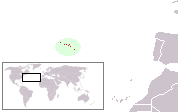The last possible explorers of America before Columbus that I will analise are probably the most famous: João Vaz Corte-Real and Álvaro Martins Homem. João Vaz is father of Gaspar and Miguel, that I will speak later. Gaspar Frutuoso, azorian historian of the XVIth century, says that João Vaz Corte-Real received the captaincy of Angra in Terceira island (in Azores) because he discovered the New Land of Codfish (Terra Nova dos Bacalhaus). If this is true, this indicates a voyage before 1474. Many historians say that this was a Frutuoso mistake, that he confused him with his sons (we will see later what his sons did).
But there is another indication of this voyage, and it cames from Scandinavia. In a letter to king Christian III of Denmark in 1551, it is read that a voyage what reali zed in the time of Christian I of Denmark (and also of Norway and Sweden, the Kalmar Union) and Afonso V of Portugal, requested by the latter. It seems that João Vaz Corte-Real and Álvaro Martins Homem participated in this luso-danish voyage, that navigated thorugh Greenland and reached North America. I would like to know exactly what this letter says, and if the names of the portuguese explorers appear, because this would be another point that would give more credibility to Frutuoso's affirmations.
zed in the time of Christian I of Denmark (and also of Norway and Sweden, the Kalmar Union) and Afonso V of Portugal, requested by the latter. It seems that João Vaz Corte-Real and Álvaro Martins Homem participated in this luso-danish voyage, that navigated thorugh Greenland and reached North America. I would like to know exactly what this letter says, and if the names of the portuguese explorers appear, because this would be another point that would give more credibility to Frutuoso's affirmations.
 zed in the time of Christian I of Denmark (and also of Norway and Sweden, the Kalmar Union) and Afonso V of Portugal, requested by the latter. It seems that João Vaz Corte-Real and Álvaro Martins Homem participated in this luso-danish voyage, that navigated thorugh Greenland and reached North America. I would like to know exactly what this letter says, and if the names of the portuguese explorers appear, because this would be another point that would give more credibility to Frutuoso's affirmations.
zed in the time of Christian I of Denmark (and also of Norway and Sweden, the Kalmar Union) and Afonso V of Portugal, requested by the latter. It seems that João Vaz Corte-Real and Álvaro Martins Homem participated in this luso-danish voyage, that navigated thorugh Greenland and reached North America. I would like to know exactly what this letter says, and if the names of the portuguese explorers appear, because this would be another point that would give more credibility to Frutuoso's affirmations.Possibly more than one voyage were realized, and in these maybe the voyage of Columbus in 1477 to these lands is part of this luso-danish effort. Please note that there is some doubt of the existence or not of ancien scandinavian colonies in Greenland when these expenditions arrived. The idea that probably interessed Portugal seems to be the possible route to Asia by North, being an alternative to the Cape route. As it woould be verified, the Cape route would be easier to perform. However, the existence of the jointly exploration only occurred due to the excellent relationship between the countries, and this is rarely indicated.




